One of the most popular European film genres of the 1950s and 1960s was the Peplum, also known as the Sword-and-Sandal epics. They were mostly produced in Italy, but the heroes were international: British, French, Dutch (!), Italian and American. The Peplum craze started in 1957, when bodybuilder Steve Reeves was invited to come to Cinécitta and play the lead character in Le fatiche di Ercole/Hercules (Pietro Francisci, 1958), opposite the gorgeous Sylva Koscina. But Italy had a long tradition of film epics about ancient Rome.

Publicity still of Cabiria (Giovanni Pastrone, 1914), the zenith of the silent Italian epics.
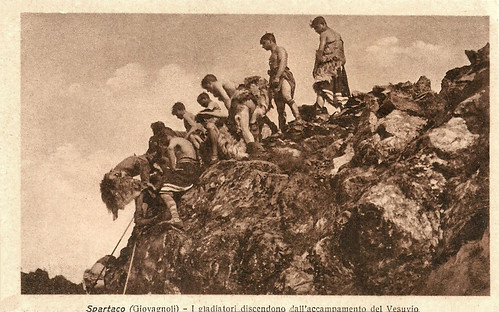
Italian postcard.
Mario Guaita aka Ausonia (1881-1956) was an Italian actor, director, producer and scriptwriter in the silent era. He had his international breakthrough with Spartaco -Il gladiatore della Tracia/Spartacus (Enrico Vidali, 1913). Caption: I gladiatori discendono dall'accampamento del Vesuvio (The gladiators descend from their camps at Mount Vesuvius). Led by Spartacus, they will conquer Crassus' army and capture the consul.
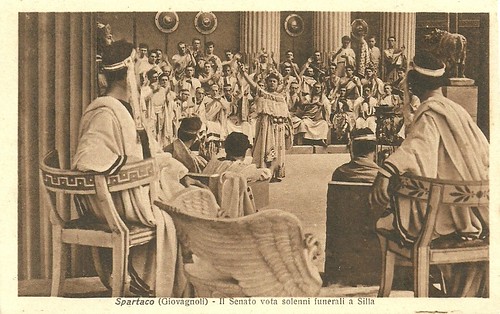
Italian postcard for the epic Spartaco - Il gladiatore della Tracia (Enrico Vidali, 1913), starring Mario Guaita - Ausonia. The film was based on a novel by Raffaello Giovagnoli. Caption: Il Senato vota solenni funerali a Silla (The Senate votes to hold a solemn funeral for Silla). This text does not correspond with what actually happens in the film: Consul Crassus evokes the Senate to destroy Spartacus's rebels.
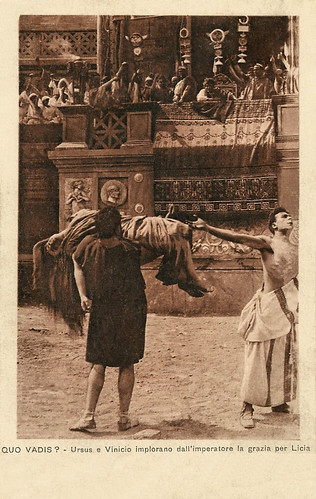
Italian postcard by Uff. Rev. St. Terni. Photo: publicity still for Quo Vadis? (Enrico Guazzoni, 1913).
Ursus (Bruto Castellani) and Vinicius (Amleto Novelli) implore the audience and emperor Nero to grace the Christian Lygia (Lea Giunchi), after Ursus has killed the bull on which back Lygia had been bound. The audience raves because of Ursus' tour de force. Vinicius has stripped his cloth to show his scars from the wars, while Ursus holds up Lygia. All around Nero hold their thumbs up for grace, even if this sign seems to have been a 19th century invention and historically incorrect.

German postcard by Ross Verlag, no. 699/3, 1919-1924. Photo: Filmhaus Bruckmann.
Publicity still for Quo vadis? (Georg Jacoby, Gabriellino D'Annunzio, 1924) with Alphons Fryland (Vinicius) and Lilian Hall-Davis (Lygia) in an adaptation of Henryk Sienkiewicz classic novel on the Rome of Nero. Here Vinicius tries to seduce the chaste Lygia during an orgy at the palace of Nero.

Italian postcard by Ed. A. Traldi, Milano, no. 738.
Rina De Liguoro dying in the final scene of Messalina (Enrico Guazzoni, 1924). The film was her breakthrough and De Liguoro became the last diva of the Italian silent cinema with notable films like Quo vadis? (Gabriellino D'Annunzio, Georg Jacoby, 1924), and Gli ultimi giorni di Pompeii/The Last Days of Pompeii (Carmine Gallone, Amleto Palermi, 1926).

Italian postcard by C. Chierichetti, Milano. Photo: Grandi Films, Roma.
Postcard for the Italian-German silent film Gli ultimi giorni di Pompei/The Last Days of Pompeii (Amleto Palermi, Carmine Gallone, 1926). The film was one of the many adaptations of the novel The Last Days of Pompeii (1834) by Edward George Bulwer-Lytton.

Italian postcard by C. Chierichetti, Milano. Photo: Grandi Films, Roma.
Another postcard for the Italian-German silent film Gli ultimi giorni di Pompei/The Last Days of Pompeii (Amleto Palermi, Carmine Gallone, 1926), starring the Hungarian actor Victor Varconi (1891–1976). He was a highly successful matinee idol of the Hungarian-Austrian and German silent cinema in the 1910s and early 1920s. Later he was the first Hungarian actor to become a Hollywood star until the sound film completely altered the course of his career.
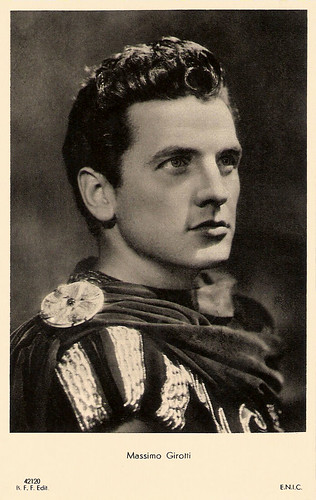
Italian postcard by B.F.F. Edit., no. 42120. Photo: E.N.I.C.
Publicity still of Massimo Girotti in La corona di ferro/The Iron Crown (Alessandro Blasetti, 1941). Blasetti gave new life to the Italian treatment of heroic mythology born in the silent era with Pastrone's Cabiria, and La corona di ferro is an important antecedents to the postwar genre of the Peplum.
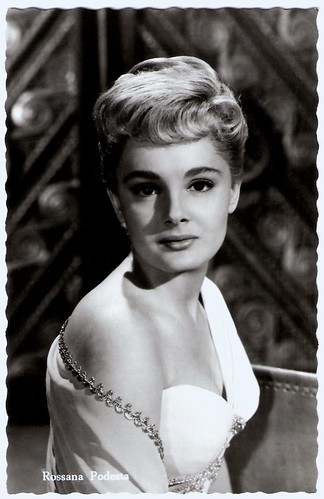
Dutch postcard by Editions P.I., no. 662.
Publicity still for Helen of Troy (1956). Italian sex siren Rossana Podestà (1934) played in many European films of the 1950s and 1960s. She is best known as the stunningly beautiful leading lady of the international spectacle Helen of Troy (Robert Wise, 1956).
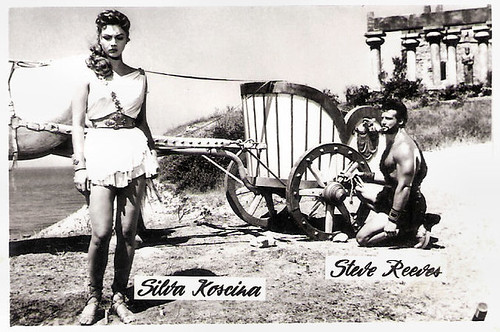
Small Romanian collectors card. Photo: publicity still for Ercole e la regina di Lidia/Hercules Unchained (Pietro Francisci, 1959) with Steve Reeves and Sylva Koscina.
Handsome, musclebound Steve Reeves (1926-2000) was an American bodybuilder and actor, who was a huge success in Hercules (1958) and other Peplum films, the Italian sword-and-sandal epics. At the peak of his career, around 1960, he was reputedly the highest-paid actor in Europe.
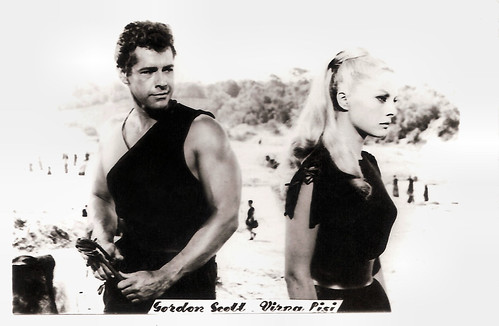
Small Romanian collectors card. Photo: publicity still for Romolo e Remo/Duel of the Titans (Sergio Corbucci, 1961) with Gordon Scott and Virna Lisi.
Good-looking and muscular American actor Gordon Scott (1926–2007) is best known as the eleventh Tarzan. He portrayed Tarzan in five films from 1955 to 1960. Then Scott moved to Italy, where he became a popular star of the Peplum film genre, the sword-and-sandal epics. When the Peplum faded, Scott starred in Spaghetti Westerns and Eurospy films.
This is a post for Postcard Friendship Friday, hosted by Beth at the The Best Hearts are Crunchy. You can visit her by clicking on the button below.


Publicity still of Cabiria (Giovanni Pastrone, 1914), the zenith of the silent Italian epics.

Italian postcard.
Mario Guaita aka Ausonia (1881-1956) was an Italian actor, director, producer and scriptwriter in the silent era. He had his international breakthrough with Spartaco -Il gladiatore della Tracia/Spartacus (Enrico Vidali, 1913). Caption: I gladiatori discendono dall'accampamento del Vesuvio (The gladiators descend from their camps at Mount Vesuvius). Led by Spartacus, they will conquer Crassus' army and capture the consul.

Italian postcard for the epic Spartaco - Il gladiatore della Tracia (Enrico Vidali, 1913), starring Mario Guaita - Ausonia. The film was based on a novel by Raffaello Giovagnoli. Caption: Il Senato vota solenni funerali a Silla (The Senate votes to hold a solemn funeral for Silla). This text does not correspond with what actually happens in the film: Consul Crassus evokes the Senate to destroy Spartacus's rebels.

Italian postcard by Uff. Rev. St. Terni. Photo: publicity still for Quo Vadis? (Enrico Guazzoni, 1913).
Ursus (Bruto Castellani) and Vinicius (Amleto Novelli) implore the audience and emperor Nero to grace the Christian Lygia (Lea Giunchi), after Ursus has killed the bull on which back Lygia had been bound. The audience raves because of Ursus' tour de force. Vinicius has stripped his cloth to show his scars from the wars, while Ursus holds up Lygia. All around Nero hold their thumbs up for grace, even if this sign seems to have been a 19th century invention and historically incorrect.

German postcard by Ross Verlag, no. 699/3, 1919-1924. Photo: Filmhaus Bruckmann.
Publicity still for Quo vadis? (Georg Jacoby, Gabriellino D'Annunzio, 1924) with Alphons Fryland (Vinicius) and Lilian Hall-Davis (Lygia) in an adaptation of Henryk Sienkiewicz classic novel on the Rome of Nero. Here Vinicius tries to seduce the chaste Lygia during an orgy at the palace of Nero.

Italian postcard by Ed. A. Traldi, Milano, no. 738.
Rina De Liguoro dying in the final scene of Messalina (Enrico Guazzoni, 1924). The film was her breakthrough and De Liguoro became the last diva of the Italian silent cinema with notable films like Quo vadis? (Gabriellino D'Annunzio, Georg Jacoby, 1924), and Gli ultimi giorni di Pompeii/The Last Days of Pompeii (Carmine Gallone, Amleto Palermi, 1926).

Italian postcard by C. Chierichetti, Milano. Photo: Grandi Films, Roma.
Postcard for the Italian-German silent film Gli ultimi giorni di Pompei/The Last Days of Pompeii (Amleto Palermi, Carmine Gallone, 1926). The film was one of the many adaptations of the novel The Last Days of Pompeii (1834) by Edward George Bulwer-Lytton.

Italian postcard by C. Chierichetti, Milano. Photo: Grandi Films, Roma.
Another postcard for the Italian-German silent film Gli ultimi giorni di Pompei/The Last Days of Pompeii (Amleto Palermi, Carmine Gallone, 1926), starring the Hungarian actor Victor Varconi (1891–1976). He was a highly successful matinee idol of the Hungarian-Austrian and German silent cinema in the 1910s and early 1920s. Later he was the first Hungarian actor to become a Hollywood star until the sound film completely altered the course of his career.

Italian postcard by B.F.F. Edit., no. 42120. Photo: E.N.I.C.
Publicity still of Massimo Girotti in La corona di ferro/The Iron Crown (Alessandro Blasetti, 1941). Blasetti gave new life to the Italian treatment of heroic mythology born in the silent era with Pastrone's Cabiria, and La corona di ferro is an important antecedents to the postwar genre of the Peplum.

Dutch postcard by Editions P.I., no. 662.
Publicity still for Helen of Troy (1956). Italian sex siren Rossana Podestà (1934) played in many European films of the 1950s and 1960s. She is best known as the stunningly beautiful leading lady of the international spectacle Helen of Troy (Robert Wise, 1956).

Small Romanian collectors card. Photo: publicity still for Ercole e la regina di Lidia/Hercules Unchained (Pietro Francisci, 1959) with Steve Reeves and Sylva Koscina.
Handsome, musclebound Steve Reeves (1926-2000) was an American bodybuilder and actor, who was a huge success in Hercules (1958) and other Peplum films, the Italian sword-and-sandal epics. At the peak of his career, around 1960, he was reputedly the highest-paid actor in Europe.

Small Romanian collectors card. Photo: publicity still for Romolo e Remo/Duel of the Titans (Sergio Corbucci, 1961) with Gordon Scott and Virna Lisi.
Good-looking and muscular American actor Gordon Scott (1926–2007) is best known as the eleventh Tarzan. He portrayed Tarzan in five films from 1955 to 1960. Then Scott moved to Italy, where he became a popular star of the Peplum film genre, the sword-and-sandal epics. When the Peplum faded, Scott starred in Spaghetti Westerns and Eurospy films.
This is a post for Postcard Friendship Friday, hosted by Beth at the The Best Hearts are Crunchy. You can visit her by clicking on the button below.

No comments:
Post a Comment